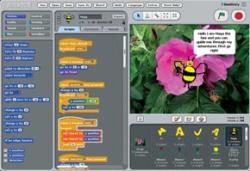
This picture has quite a bit of significance for me. It first caught my eye in the New Scientist edition of 2nd August 2008. It filled the top half of the page and is, as you can see, a colourful picture. I was a primary school teacher at the time and recognised this as software I could use in school. I read the article and was excited when I saw this was a free download. Being especially interested in ICT as a teaching tool and also having enjoyed programming as a child, I downloaded it and had a go.
It took me awhile to try it out properly - as a teacher I was busy and had many over responsibilities, but it was always there in the back of my mind. I knew it had potential.
At the time I was looking for new ways to approach ICT (as I now realise, from a computer science point of view) because the scheme of work we had in school was very dated. As an example, one of the units of work for Year 6, which was supposed to last for half of a term, was on MS Powerpoint. Most of my Year 6 students already knew most of it and could achieve the end-of-unit objectives by the end of the first lesson. I developed on the basic ideas - using hyperlinks to create quest stories in Powerpoint was one of my favourite ideas and I still have a bit of a soft spot for many of these produced by my classes - but still the curriculum was lacking.
Still we had the end of primary school tests (SATs) to prepare for so it wasn't until these were out of the way that I looked at using Scratch in school. This was in the spring of 2009. Since then I've had a lot of experience of using Scratch in school and it's about time I reflected in detail about the effect Scratch has had on my teaching and the students' learning, and arrange my various lessons into some sort of 'scheme of work'. It is my hope that these ideas could prove useful as computer science and programming takes on a higher profile in schools, especially with the introduction of the Raspberry PI.
Over the coming weeks I will blog on these reflections and post any resources I believe may be useful.